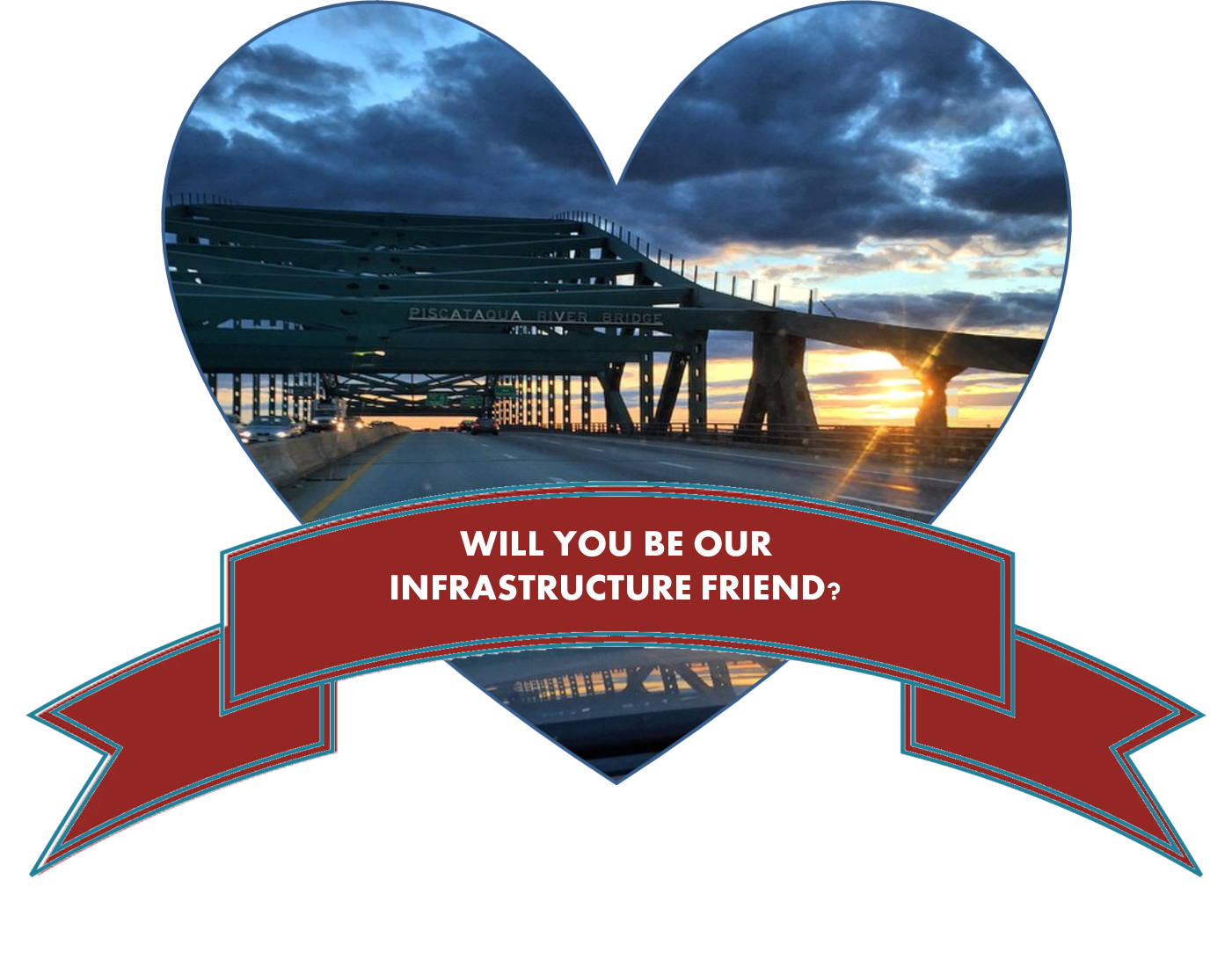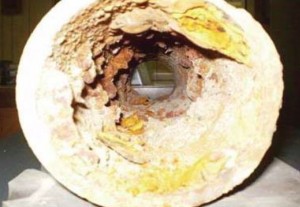2015 Report Card for Iowa’s Infrastructure Arrives Next Tuesday
February 19th, 2015 | By: Infrastructure Report Card
The Iowa Section of the American Society of Civil Engineers (ASCE) will release the inaugural 2015 Report Card for Iowa’s Infrastructure on Tuesday, February 24. The report includes evaluations of Iowa aviation, rail, inland waterways, roads, bridges, dams, levees, drinking water, wastewater, electrical energy, and solid waste.News conference on release of the 2015 Report Card for Iowa’s Infrastructure
WHO: American Society of Civil Engineers – Iowa Section
Speakers:
- Joe Spradling, P.E., president, Iowa Section ASCE
- Aaron Granquist, P.E., author and member, Report Card Committee
- Director Debi Durham, Iowa Economic Development Authority
WHEN: Tuesday, February 24, 2015 at 10:30 am
WHERE: Wallace Building Auditorium, 502 E 9th Street, Des Moines, Iowa
Tags: bridges, economy, infrastructure, Iowa, report card, roads, transportation, water
No Comments »
Show Your Love for Infrastructure
February 13th, 2015 | By: Infrastructure Report Card
Since we launched our Infrastructure Friends network with the release of ASCE’s 2013 Report Card for America’s Infrastructure we’ve seen a wave of new momentum on infrastructure issues in every state and in DC. We hope you’ll join our effort and be a friend to America’s infrastructure!
Tags: friend, infrastructure, report card
No Comments »
Senator’s 2020 Vision For America’s Infrastructure
January 27th, 2015 | By: Becky Moylan
Aging infrastructure, graded at a D+ national GPA, is no secret. In fact, it is the news each and every day. From a water main break that hindered a morning commute in DC, to the potholes that inhibit safe driving, Americans across the country are experiencing inconveniences and challenges because of deficient roads, bridges, water pipes and other infrastructure. Furthermore, we have an investment shortfall across our major infrastructure sectors of just over $200 billion a year. Underinvesting in these vital systems costs us more in the long run. Today, Sen. Sanders shared his bill as a vision to better fund infrastructure and address the backlog of needs. As the new ranking member of the Senate Budget Committee, Sen. Sanders is taking the opportunity to introduce a $1 trillion, five-year plan for the nation’s infrastructure. The measure would inject an additional $75 billion a year into the Highway Trust Fund, create a national infrastructure bank and expand financing and grant programs. Additionally, it would fund freight and passenger rail improvements, airports, water projects, ports and inland waterways and national parks, along with broadband and electric networks. ASCE’s Casey Dinges joined the Senator from Vermont to share our vision of what needs to happen to improve our nation’s infrastructure. During his remarks, Casey said “By taking steps to invest in our nation’s infrastructure, the U.S. can protect $3.1 trillion in GDP, $1.1 trillion in U.S. trade value and 3.5 million jobs and a little over $3,000 a year per family. Without these investments, infrastructure – the backbone of our nation’s economy – will continue to decline and Americans will pay the price.” With the need to #FixTheTrustFund looming ahead, this bill is a positive step in the conversation and a good reminder that inaction is not an option.Tags: #fixthetrustfund, aviation, bridges, report card, roads, transportation
3 Comments »
Increased Optimism for Infrastructure Funding Fix
January 16th, 2015 | By: Olivia Wolfertz
With Congress mapping out transportation plans for the upcoming year and the increasing need for infrastructure investment, it is critical that lawmakers work expeditiously and in a bipartisan manner to address our nation’s dire infrastructure needs. ASCE applauds the Obama Administration’s announcement this week on increasing private investment to infrastructure through its Build America Investment Initiative. Transportation Secretary Anthony Foxx revealed that the White House’s 30-Year Transportation Plan will address funding needs in light of the nation’s rapid population growth and aging infrastructure. Fox indicated, “We must make our solutions as big as our problems” and warned that “not having a plan is the same as having a plan to fail.” A recent New York Times article restated the spiral effects of our country’s insufficient road and transit systems. These subpar transit systems cost our country billions in increased delays, extra fuel costs and auto repair bills. Not to mention poor road conditions contribute to about one-third of all traffic fatalities, or about 10,000 deaths a year. With time running out to #FixtheTrustFund, we hope that members of Congress will work together to pass legislation that will provide long-term sustainable funding for America’s surface transportation systems.Tags: congress, highway trust fund, report card
No Comments »
Nevada Report Card Reveals a $15B Infrastructure Problem
December 16th, 2014 | By: Infrastructure Report Card
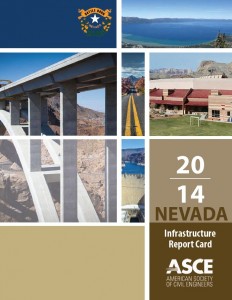 During the past twenty years Nevada experienced one of the largest growth surges in the country and then one of the worst downturns from late 2008 through 2013. This roller coaster economy decreased funding levels and preventive maintenance suffered leaving many infrastructure systems underfunded. Hardest hit may be school facilities in both rural communities and cities. Nevada’s funding for maintaining schools stagnated and left a funding shortfall of over $5 billion during the next 5 to 10 years.
The 2014 Report Card for Nevada’s Infrastructure, released today by the Nevada Section of the American Society of Civil Engineers (ASCE), gave the state’s infrastructure a grade of “C-.” The Report Card identifies more than 15 billion in needs across Nevada’s critical infrastructure sectors over 20 years, including:
Dams and Flood Control:
During the past twenty years Nevada experienced one of the largest growth surges in the country and then one of the worst downturns from late 2008 through 2013. This roller coaster economy decreased funding levels and preventive maintenance suffered leaving many infrastructure systems underfunded. Hardest hit may be school facilities in both rural communities and cities. Nevada’s funding for maintaining schools stagnated and left a funding shortfall of over $5 billion during the next 5 to 10 years.
The 2014 Report Card for Nevada’s Infrastructure, released today by the Nevada Section of the American Society of Civil Engineers (ASCE), gave the state’s infrastructure a grade of “C-.” The Report Card identifies more than 15 billion in needs across Nevada’s critical infrastructure sectors over 20 years, including:
Dams and Flood Control:
- With the majority of funding for flood management coming from local gas and sales tax initiatives, there continues to be projected funding shortfalls upwards of $400 million.
- The state has 158 high hazard dams, which could lead to loss-of-life or significant property damage if dam failure occurs.
- The state budget for high hazard dams is nearly half the national average.
- In 2005, $500,000 of investments were made in aviation through the Nevada Aviation Trust Fund, resulting in an economic impact of over $20 million. However, since that time no state funding has been allocated into the Trust Fund to leverage federal funding.
- The Nevada Department of Transportation maintains 5,300 miles of state highways, which include many rural roadways within Nevada.
- Current funding levels provide only 60 to 70 percent of the required funding to maintain state highways.
- In Clark and Washoe Counties, 45 percent of schools are more than 30 years old.
- In other counties throughout the state, there are schools with campuses over 100 years old.
- Every dollar held back from school operation and maintenance budgets escalates emergency repair budgets 400 percent.
Tags: #HighwayTrustFund, dams, flood control, Nevada, report card, roads, schools
No Comments »
8 Things Worth Knowing About Montana’s C- Infrastructure
November 19th, 2014 | By: Infrastructure Report Card
Montana’s Water Pipes Could Stretch From Billings to Miami – Roundtrip Montana has approximately 700 public water systems and over 5,300 miles of water distribution and transmission piping, a longer stretch than driving roundtrip from Billings to Miami. Some Pipes Under Original Montana Plots Might Be Original Too Some of the older and more established communities in Montana have pipes that date back to the late 1800s and early 1900s and much of the pipe has never been replaced. It is not uncommon for the pipelines in originally established areas to have clay tile pipe that has cracked or failed. Montana’s Rough Roads Are Rough On Budgets 46% of major roads in Montana are in poor to mediocre condition and 40% of gravel roads are in poor or failed condition. These rough roads cost each Montanan approximately $292 to $484 per year in extra maintenance costs depending on their area’s roads. Montana School Buildings Need Some T.L.C. A bottom-to-top statewide school facilities review revealed that 66% of schools showed signs of damage and wear, as well as environmental needs such as HVAC, roof, and electrical issues. Old Dams Don’t Necessarily Have to Be Inspected The overall condition of Montana’s dams is difficult to track because 75% do not have periodic engineering inspections and are not required to have operation permits. Transit Funding Recently Spiked Several agencies benefited from over $15 million in Federal recovery investments in 2009, which essentially doubled short-term transit funding in the state. Montana’s Trash Ends Up In Less Places Since 1993, significant improvements have occurred within Montana’s solid waste infrastructure and operations, including a reduction from over 300 facilities statewide to just 31. Replacing Montana’s Water and Wastewater Infrastructure Could Cost More than 500 Bobcat Stadiums Current estimates to completely replace Montana’s entire water and wastewater infrastructure are estimated to range between $12 billion and $15 billion, or in other terms, more than 500 Montana State University’s Bobcat Stadiums. Find out more about the inaugural Report Card for Montana’s Infrastructure!Tags: dams, infrastructure, Montana, pipes, report card, schools, water
No Comments »
Infrastructure in Arkansas Earns D+
October 17th, 2014 | By: Infrastructure Report Card
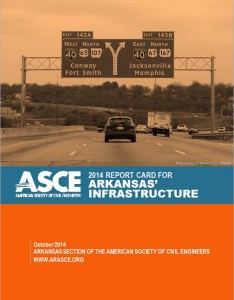 This Thursday, the Arkansas Section of the American Society of Civil Engineers released their inaugural Infrastructure Report Card for the state grading the states’ infrastructure.
Arkansas’ infrastructure received a cumulative GPA of “D+” in the 2014 Report Card for Arkansas’ Infrastructure. The seven infrastructure categories evaluated in the report include:
Roads (D+)
Drinking water (D+)
Transit (D+)
Levees (D)
Dams (D)
Bridges (C+)
Wastewater (C+)
The report noted that Arkansas has the 12th largest highway system in the nation, as well as the second highest traffic fatality rate in the country as of 2010. In addition, the state has 214 wastewater treatment facilities that will need upgrades and improvements in the next 20 years.
The Report Card, the first for Arkansas, was released during the annual ASCE Arkansas Section Conference and included a keynote address by Scott Bennett, director of the Arkansas State Highway and Transportation Department. The report was featured in both the Arkansas Democrat-Gazette and the Times-Record. The effort was led by Aaron Robinson, P.E., based in Jacksonville, Arkansas.
Read the full Arkansas Report Card
This Thursday, the Arkansas Section of the American Society of Civil Engineers released their inaugural Infrastructure Report Card for the state grading the states’ infrastructure.
Arkansas’ infrastructure received a cumulative GPA of “D+” in the 2014 Report Card for Arkansas’ Infrastructure. The seven infrastructure categories evaluated in the report include:
Roads (D+)
Drinking water (D+)
Transit (D+)
Levees (D)
Dams (D)
Bridges (C+)
Wastewater (C+)
The report noted that Arkansas has the 12th largest highway system in the nation, as well as the second highest traffic fatality rate in the country as of 2010. In addition, the state has 214 wastewater treatment facilities that will need upgrades and improvements in the next 20 years.
The Report Card, the first for Arkansas, was released during the annual ASCE Arkansas Section Conference and included a keynote address by Scott Bennett, director of the Arkansas State Highway and Transportation Department. The report was featured in both the Arkansas Democrat-Gazette and the Times-Record. The effort was led by Aaron Robinson, P.E., based in Jacksonville, Arkansas.
Read the full Arkansas Report Card
Tags: Arkansas, bridges, dams, infrastructure, levees, report, report card, roads, transit, wastewater, water
No Comments »
Vermont Infrastructure Shows Improvement in New Report Card
October 17th, 2014 | By: Infrastructure Report Card
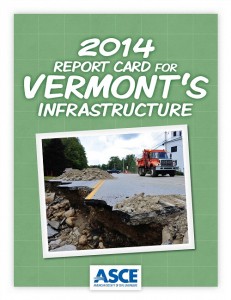 The latest Report Card for Vermont’s Infrastructure showed a slight improvement in their overall GPA to a “C.” The 2014 Report Card for Vermont’s Infrastructure is an update from 2011, when the state received a “C-” cumulative grade. The Report Card assessed bridges (C), dams (C), drinking water (C-), wastewater (D), roads (C-), and solid waste (C+).
After Tropical Storm Irene damaged the state’s infrastructure backbone in 2011, Vermont made significant investments through catch-up and emergency funding. In addition, the state’s most recent transportation funding package provided close to $700 million for transportation infrastructure, the largest transportation infrastructure investment in state history. There have also been programmatic changes. Road fatalities have been cut nearly in half since 2006 due to changes made using the Strategic Highway Safety Plan.
Led by Amanda Hanaway-Corrente, P.E. who chaired the effort and Vermont Section President-Elect Jessica Clark Louisos, P.E., the Report Card was released at a luncheon in Montpelier, which included a keynote from Sue Minter, deputy secretary at the Vermont Agency of Transportation (VTRANS) and David Mears, commissioner of the Department of Environmental Conservation.
“Vermont is poised to grow our economy as we continue to make investments into our infrastructure. The transportation funding that was signed into law in June is one example of how the state continues to focus on innovation and jobs,” said Minter.
Media coverage of the event included the Burlington Free Press and WCAX.
Read the full Vermont Report Card
The latest Report Card for Vermont’s Infrastructure showed a slight improvement in their overall GPA to a “C.” The 2014 Report Card for Vermont’s Infrastructure is an update from 2011, when the state received a “C-” cumulative grade. The Report Card assessed bridges (C), dams (C), drinking water (C-), wastewater (D), roads (C-), and solid waste (C+).
After Tropical Storm Irene damaged the state’s infrastructure backbone in 2011, Vermont made significant investments through catch-up and emergency funding. In addition, the state’s most recent transportation funding package provided close to $700 million for transportation infrastructure, the largest transportation infrastructure investment in state history. There have also been programmatic changes. Road fatalities have been cut nearly in half since 2006 due to changes made using the Strategic Highway Safety Plan.
Led by Amanda Hanaway-Corrente, P.E. who chaired the effort and Vermont Section President-Elect Jessica Clark Louisos, P.E., the Report Card was released at a luncheon in Montpelier, which included a keynote from Sue Minter, deputy secretary at the Vermont Agency of Transportation (VTRANS) and David Mears, commissioner of the Department of Environmental Conservation.
“Vermont is poised to grow our economy as we continue to make investments into our infrastructure. The transportation funding that was signed into law in June is one example of how the state continues to focus on innovation and jobs,” said Minter.
Media coverage of the event included the Burlington Free Press and WCAX.
Read the full Vermont Report Card
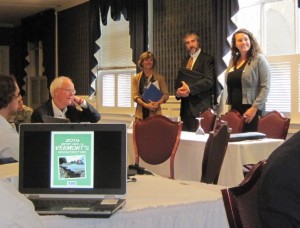

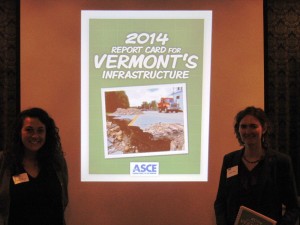
Tags: bridges, dams, grade, infrastructure, report card, roads, transportation, Vermont, wastewater, water
No Comments »
Is Our Infrastructure Making the Grade? We Know the Answer
July 22nd, 2014 | By: America's Infrastructure Report Card
A few weeks ago, a new report from CG/LA Infrastructure and Autodesk offered a six-point plan to address the dismal D+ grade from our 2013 Report Card for America’s Infrastructure. As Rep. John Delaney (D-MD) put it, “there are real economic costs associated with our infrastructure gridlock. This is a domestic emergency.” Throughout the new report, we see many parallels between the six recommendations and both the Vision and Key Solutions offered in our Report Card: leadership at all levels of government, promoting sustainability and resilience, and making sure that we have comprehensive plans in place to make the best decisions on how to spend our limited dollars. Perhaps the most critical point between the two reports is that we need to view all of the recommendations through the lens of an interconnected infrastructure system. It’s not about choosing a sector to prioritize first – whether that be roads, water, or our energy grid. Unfortunately, our maze of agencies and jurisdictions that deal with infrastructure policy are most often set up that way. In order to keep the momentum going to raise the grades, we are going to have to embrace a holistic method of infrastructure planning that recognizes that the system is only as good as its weakest link. Our water treatment plans rely on vast quantities of energy. Our ports rely on reliable roads and railroad connections to move goods off the docks to your local store. We know that long-term planning, leadership, and innovation are the answers. We have examples of cities and states that are tackling ambitious projects across our infrastructure modes, but we need more of this type of leadership. Only then will we have an infrastructure system ready to support a growing 21st-century economy.5 Graphics Every Pennsylvania Driver Should See
July 17th, 2014 | By: Infrastructure Report Card
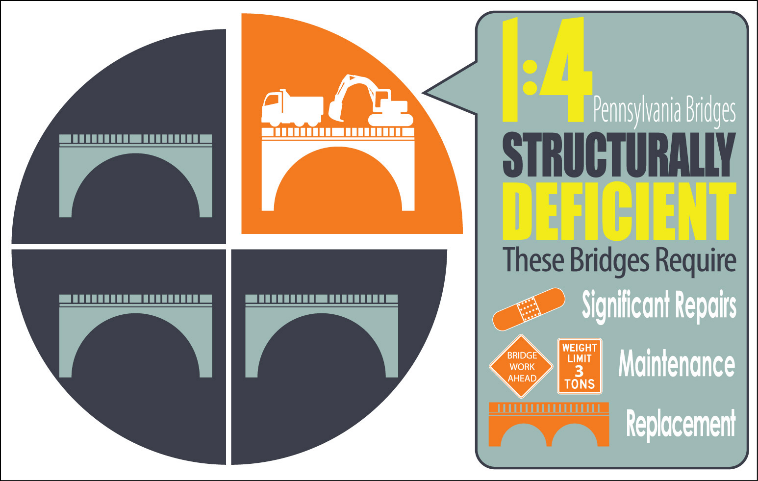
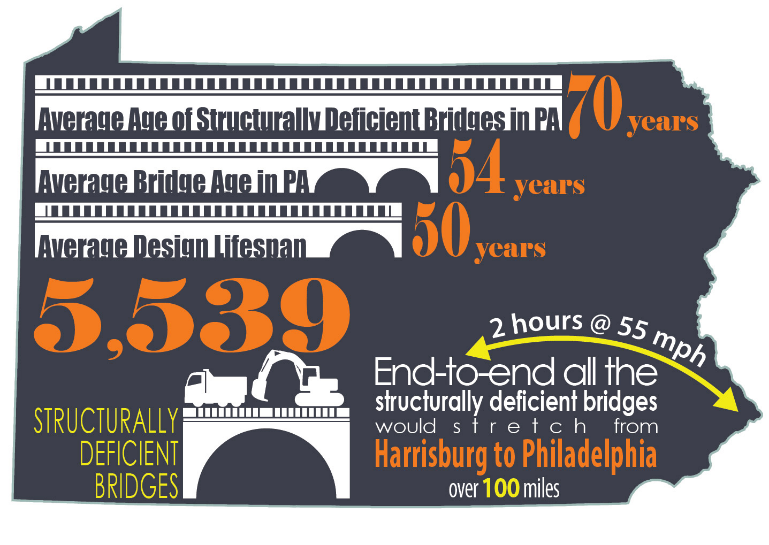
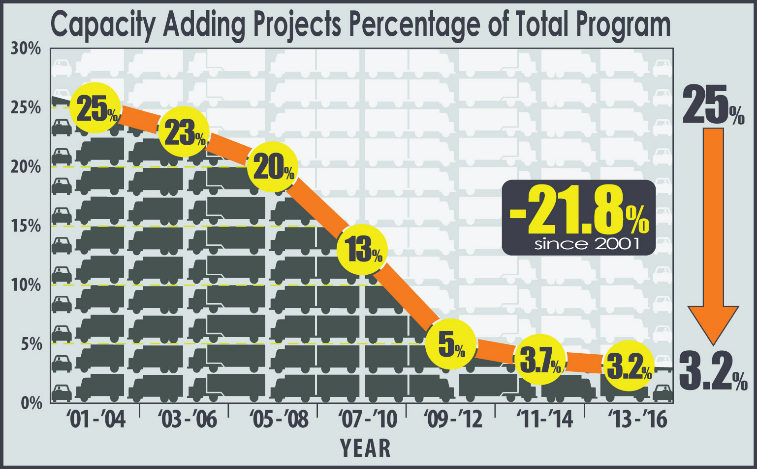
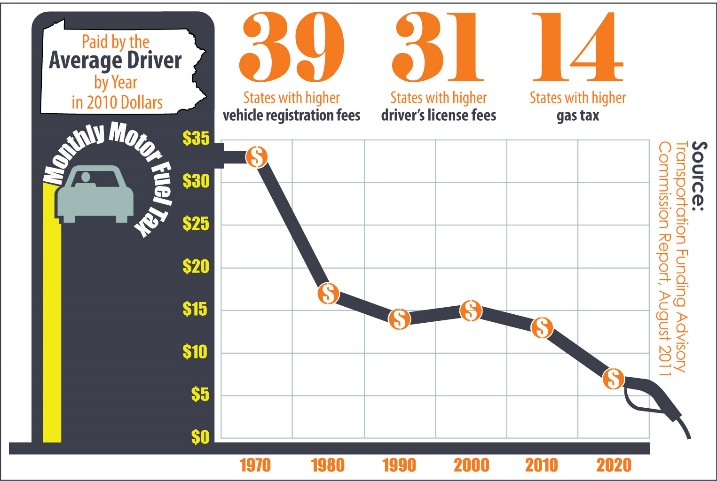
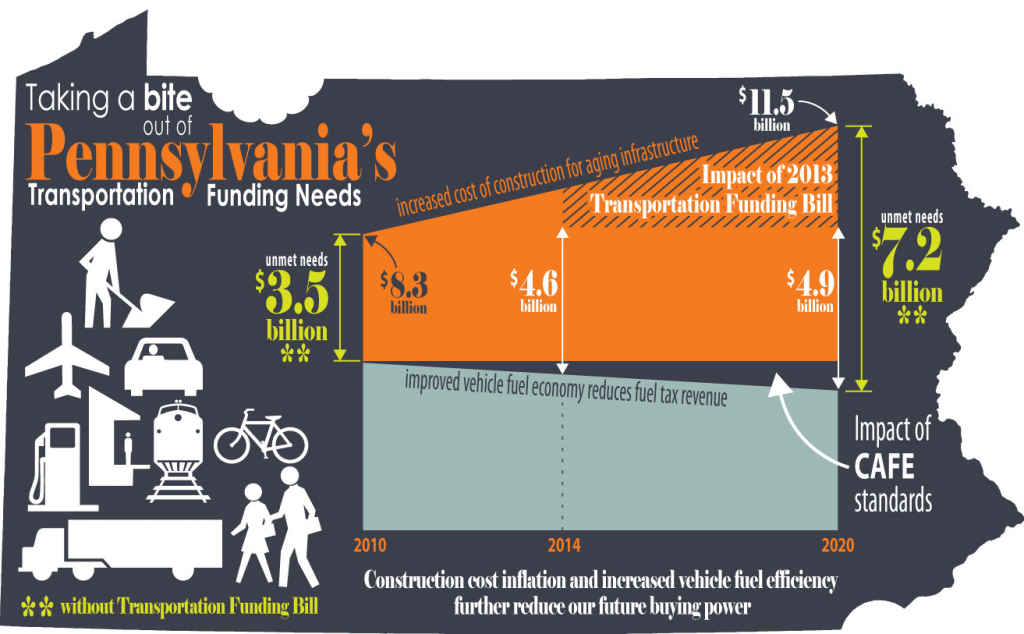 In 2013, Pennsylvania stepped up to start addressing these problems with a transportation funding package, but even with it, there’s still more work to be done than the funding that’s available. Also, if Congress fails to come up with their promised funding by the end of August, this could set Pennsylvania back in spite of trying to catch up on their transportation needs. Pennsylvania has done their part, Congress should really get to work on theirs.
Want to find out more about Pennsylvania’s other infrastructure? Start with the 2014 Report Card for Pennsylvania’s Infrastructure!
Images created by Jason Forbes of McCormick Taylor
In 2013, Pennsylvania stepped up to start addressing these problems with a transportation funding package, but even with it, there’s still more work to be done than the funding that’s available. Also, if Congress fails to come up with their promised funding by the end of August, this could set Pennsylvania back in spite of trying to catch up on their transportation needs. Pennsylvania has done their part, Congress should really get to work on theirs.
Want to find out more about Pennsylvania’s other infrastructure? Start with the 2014 Report Card for Pennsylvania’s Infrastructure!
Images created by Jason Forbes of McCormick Taylor
Tags: #fixthetrustfund, bridges, congress, Pennsylvania, report card
No Comments »



 */ ?>
*/ ?>




